
Baden-Baden is a spa town in the state of Baden-Württemberg, south-western Germany, at the north-western border of the Black Forest mountain range on the small river Oos, ten kilometres east of the Rhine, the border with France, and forty kilometres north-east of Strasbourg, France.
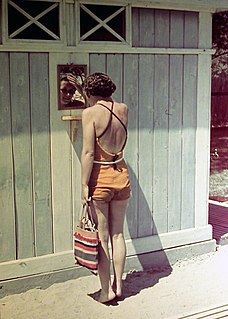
A spa town is a resort town based on a mineral spa. Patrons visit spas to "take the waters" for their purported health benefits. The word spa is derived from the name of Spa, a town in Belgium.

Karlovy Vary is a spa city in the Karlovy Vary Region of the Czech Republic. It has about 48,000 inhabitants. It lies on the confluence of the rivers Ohře and Teplá, approximately 130 km (81 mi) west of Prague. It is named after Charles IV, Holy Roman Emperor and the King of Bohemia, who founded the city in 1370. It is the site of numerous hot springs, and is the most visited spa town in the Czech Republic. Until 1945, when the German-speaking inhabitants were expelled, the city was overwhelmingly German-speaking.

In ancient Rome, thermae and balneae were facilities for bathing. Thermae usually refers to the large imperial bath complexes, while balneae were smaller-scale facilities, public or private, that existed in great numbers throughout Rome.
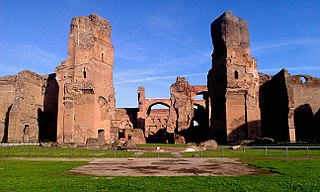
The Baths of Caracalla in Rome, Italy, were the city's second largest Roman public baths, or thermae, likely built between AD 212 and 216/217, during the reigns of emperors Septimius Severus and Caracalla. They were in operation until the 530s and then fell into disuse and ruin.

Bad Kissingen is a German spa town in the Bavarian region of Lower Franconia and seat of the district Bad Kissingen. Situated to the south of the Rhön Mountains on the Franconian Saale river, it is one of the health resorts, which became famous as a "Weltbad" in the 19th century.
A spa is a location where mineral-rich spring water is used to give medicinal baths. Spa towns or spa resorts typically offer various health treatments, which are also known as balneotherapy. The belief in the curative powers of mineral waters goes back to prehistoric times. Such practices have been popular worldwide, but are especially widespread in Europe and Japan. Day spas are also quite popular and offer various personal care treatments.
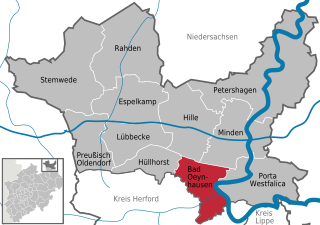
Bad Oeynhausen is a spa town on the southern edge of the Wiehengebirge in the district of Minden-Lübbecke in the East-Westphalia-Lippe region of North Rhine-Westphalia, Germany. The closest larger towns are Bielefeld and Hanover.

Františkovy Lázně is a spa town in Cheb District in the Karlovy Vary Region of the Czech Republic. It has about 5,500 inhabitants. Together with neighbouring Karlovy Vary and Mariánské Lázně, it is part of the renowned West Bohemian Spa Triangle. The town centre is well preserved and historically significant and since 1992 is protected by law as urban monument reservation. It was nominated for inclusion in the UNESCO World Heritage roster.

Velingrad is a town in Pazardzhik Province, Southern Bulgaria, located at the western end of Chepino Valley, part of the Rhodope Mountains. It is the administrative center of the homonymous Velingrad Municipality and one of the most popular Bulgarian balneological resorts. The town has a population of 22,602 inhabitants according to the 2011 census of Velingrad.
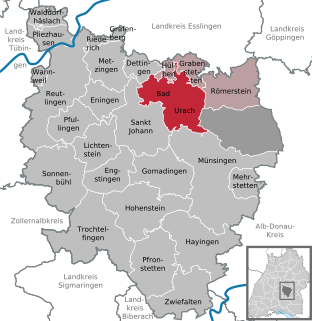
Bad Urach is a town in the district of Reutlingen, Baden-Württemberg, Germany. It is situated 14 km east of Reutlingen, at the foot of the Swabian Alb, and is known for its spa and therapeutic bath.

7132 Thermal Baths is a hotel/spa complex in Vals, built over the only thermal springs in the Graubünden canton in Switzerland. Completed in 1996, the spa was designed by Peter Zumthor.

Chianciano Terme is a comune (municipality) in the Province of Siena in the Italian region Tuscany, located about 90 kilometres (56 mi) southeast of Florence and about 50 kilometres (31 mi) southeast of Siena. It is located between the Valdichiana and the Val d'Orcia.
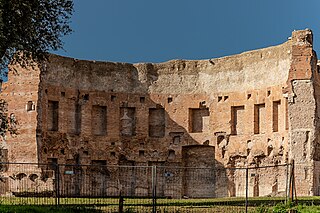
Bathing played a major part in ancient Roman culture and society. It was one of the most common daily activities in Roman culture and was practiced across a wide variety of social classes.

There is a long history of tourism in Hungary, and Hungary was the world's thirteenth most visited tourist destination country in 2002. Tourism increased by nearly 7 percent between 2004 and 2005. European visitors comprise more than 98 per cent of Hungary's tourists. Austria, Germany, and Slovakia make the largest numbers of visitors to the country. Most tourists arrive by car and stay for a short period of time. Hungary's tourist season is from April through October. July and August are the best tourist months. Budapest is the country's most popular tourist destination.

Buxton Crescent is a Grade-I-listed building in the town of Buxton, Derbyshire, England. Owing much to the Royal Crescent in Bath, but described by the Royal Institution of British Architects as "more richly decorated and altogether more complex". It was designed by the architect John Carr of York, and built for the 5th Duke of Devonshire between 1780 and 1789. In 2020, following a multi-year restoration and redevelopment project supported by the National Heritage Memorial Fund and Derbyshire County Council, The Crescent was reopened as a 5-star spa hotel.

Spa architecture is the name given to buildings that provide facilities for relaxation, recuperation and health treatment in spas. The architecture of these buildings is called "spa architecture" even though it is not a uniform architectural style, but a collective term for a genre of buildings with a spa function.
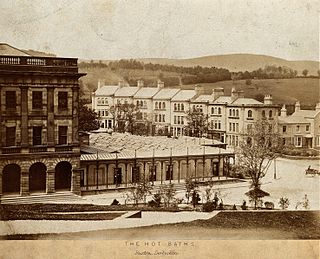
The Buxton Baths using natural thermal spring water are in Buxton, Derbyshire, England. The baths date back to Roman times and were the basis for developing Buxton as a Georgian and Victorian spa town. The present buildings of the Thermal Baths and the Natural Mineral Baths were opened in the 1850s. They are positioned either side of the Buxton Crescent at the foot of The Slopes in the town's Central Conservation Area. They are both Grade II listed buildings designed by Henry Currey, architect for the 7th Duke of Devonshire.

Victorian Turkish bath or simply Turkish bath is a type of public bathhouse which was derived from the hammam (bathhouse) of the Islamic world and those Roman baths which used hot dry air. It became popular as a therapy, a method of cleansing, and a place for relaxation during the Victorian era, rapidly spreading through the British Empire, the United States of America, and Western Europe.
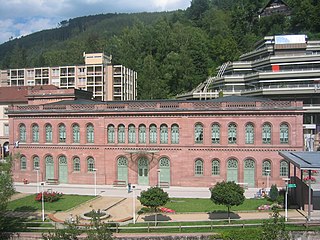
The Palais Thermal is a spa in Bad Wildbad in Germany. The construction for the spa building was finished in 1847 and opened under the name of Graf-Eberhard-Bad.




























